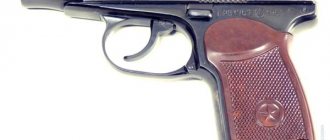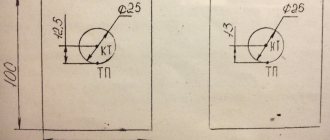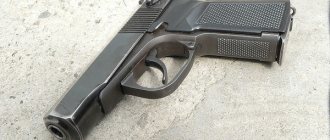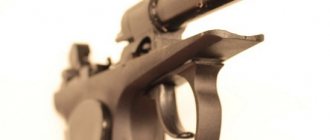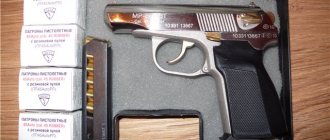Traumatic weapons by definition refer to means of self-defense. In Russian legislation it is defined as a firearm of limited destruction. This is a device designed for the use of traumatic cartridges, which serves to defeat a living target, but does not lead to the death of a person.
Since 2011, only domestic samples have received an LLC certificate. With all the variety of trauma equipment, those models that are structurally or only externally similar to combat models are especially popular. There are at least two reasons for this popularity.
- Pistols created on the basis of real combat models have fairly high impact and energy indicators. They are reliable and durable, since all elements are made of durable material - special weapon steel.
- Pistols, which are copies developed from scratch, solve approximately half of the problems in the field of self-defense with their appearance alone.
It is in the second category that a number of models that are considered an analogue of the legendary PM (Makarov) can be attributed. All these models are united by one popular name - “Makarych”.
History of the PM pistol
All major changes, in contrast to the combat model, were limited to the installation of a smooth barrel.
The creation of the first traumatic Makarov pistols began in the 90s, and mass sales only by the beginning of the 2000s. Production took place at the factories of OJSC ZID and LLC PKP AKBS, which continue the production of combat PM. The number of manufactured pistols of 5,000 thousand pieces classifies this model as small-scale production. Amendments to the legislation on the use of traumatic weapons have limited the assembly and sale of weapons using rubber ammunition. This is precisely the reason for the suspension of the subsequent distribution of this model on the market.
Using materials from used real pistols would increase the cost and decrease popularity among buyers; in addition, most collectors bought these weapons for their authenticity and the installation of original parts.
The price of pistols before the change in legislation was approximately 12 thousand rubles, then the price gradually increased and reached 100 thousand rubles. for models in new condition with combat mechanisms and body elements.
By 2022, many copies had failed due to wear and tear of the component parts, but the availability of a large spare parts database simplified the repair and use of the gun. Moreover, the price of these traumatic weapons increases annually and reaches an average of 35-45 thousand rubles. taking into account the condition and wear of a particular instance.
Thanks to the use of original parts, replacing broken parts is not difficult, and the price of spare parts itself, unlike foreign analogues, is 2 times lower.
True Trauma
“Makarych” should not be confused with the PM-T traumatic pistol, which was created from a combat PM using the method of alterations. The trauma equipment we are considering was created independently, copying the appearance of the PM pistol as much as possible. However, there is no talk of constructive similarity and complete external similarity. The entire mechanism has nothing in common with the trigger of a combat pistol.
Over the course of several years of the heyday of traumatic weapons, the Izhevsk Mechanical Plant produced several modifications of the Makarych, which differed primarily in caliber.
The developers took an independent step, eliminating the basis of the combat PM, for reasons that owners of traumatic pistols would not think of converting them to use live ammunition. The Makarych series of pistols, developed by ZAO TsSZ Kolchuga and the Izhevsk Mechanical Plant, includes models such as Izh-79-9T, MP-79-9TM and MP-80-13T. As for the caliber, here it varies from 9 to 13 mm.
The three models we have chosen are considered representatives of the same line. They were released at different times and each subsequent model serves as a continuation of the previous one with certain improvements. However, even the earliest versions have their own distinctive features that cannot be missed, so we will conduct a comparative analysis of the presented models, highlighting their advantages and disadvantages.
Release of PM-T
The new weapon received high praise immediately after its first presentation. The interest of collectors was fueled by the fact that the manufacturer did not intend to release a large number of copies. Combining rarity, quality and historical value, the PM-T has become a real bestseller on the arms market.
The main reason for the low output was the state. It issued a bill that, from July 1, 2011, prohibited the production of weapons for civilian self-defense that would use rubber bullets as a charge. That is why the manufacturer’s task was to produce as many copies of PM-T as possible before the appointed day.
Pistol PM-T
The result was quite expected. On the very first day of pistol sales, huge lines formed in gun stores from the very morning; people bought a gun in any condition of the case with any release date. The happy owners of 5 thousand copies of PM-T do not regret their choice, because they bought them for 16-18 thousand rubles, and now they can easily sell them for 50-100 thousand rubles.
How the gun works
Semi-automatic shooting is implemented on the principle of using recoil with a free shutter. Double-action trigger mechanism, release is carried out with a warning. The required force for a shot is 2 or 4.5 kilograms in single action or self-cocking mode, respectively. However, the trigger guard of the Soviet Makarov has always been distinguished by its smoothness, and the PM-T is no worse in this sense.
In addition to the already mentioned pin in the barrel, in order to prevent firing live ammunition, the barrel is equipped with weakening grooves. There are no practical advantages to this: this is done only to comply with weapons legislation.
Sighting devices consist of a fixed front sight mounted on the bolt casing and a rear sight with the possibility of lateral adjustments mounted on a dovetail mount - there are no differences from the PM.
The single-stack magazine holds eight rounds and is secured with a spring latch at the bottom of the handle. This solution adds reliability, but at the expense of reload speed, however, it can be called justified.
What weapons are most often remade?
What are the modifications of the MP-371?
Conventionally, they can be divided into 2 types: criminal and non-criminal.
The first is when a signal pistol is converted to fire traumatic or live ammunition.
The second is when the pistol, without acquiring damaging properties, receives some internal or external improvements.
If everything is clear with the first case, then with the second there are many nuances.
For example, the most common modification of the MP-371 is the introduction of automatic weapon reloading, when the owner implements the operation of the automation like a combat analogue. This eliminates the need to manually pull the bolt before each shot.
When fired, the pistol automatically removes the cartridge with the spent Zhevelo primer and, with the movement of the bolt forward, sends a new cartridge into the chamber. It is this alteration, which is also called the fashionable word “tuning,” that does not threaten the owner with absolutely anything, since the MP-371 has not lost its properties as a signal weapon and has not acquired the destructive properties of a firearm, remaining the same MP-371 according to the certificate.
Design
The PM injury is not a simple traumatic weapon. This pistol is a limited-kill firearm. It has an external resemblance to Makarych, but if you thoroughly disassemble the device, principle of operation and individual parts, it will become clear that the PM-17T is an object that has the right to life as an individual. Key Features:
- Different outer surface. Another quality of barrel polishing. A unique technology using modern equipment is used.
- Modified controls. In addition to the trigger, the barrel has been changed. It has an imitation of “rifling” on the muzzle. Another spring mechanism valve has been installed. Now it is milled, created on a modernized machine. The magazine is slightly elongated.
- Different color of protective coating. Now it is not completely black, but has a sea-green tint when viewing the injury under the rays of the sun or good lighting.
It should be mentioned that the designers paid special attention to spare parts. Thus, the fastening screw on the handle was replaced with another, longer one with a relief, as well as a groove for fastening. It is convenient to care for the weapon due to modifications, because traumatic objects are prone to thermal oxidation. Experienced shooters can easily change their grip due to the large, duplicated notch on the outer surface of the bolt. There is an anti-reflective knurling along the ridge, which guarantees the shooter's invisibility.
Enlarged rear sight and front sight. It’s difficult to notice this visually, but if you take measurements, the difference is significant. This makes the P-M17T more similar to the silent Makarych variant. This nuance also ensures more productive shooting in low light. The ergonomic shape has no sharp protrusions that will catch on clothing or damage the material. It is convenient to charge the device even with one hand. Technological features of the shutter: it is cast, made from solid milled parts.
The presence of a free bolt ensures that the barrel is locked due to the inert mass. In this case, the spring does not participate in the process, but only returns to its original position after the action is completed. An important point: there is a risk of an unauthorized shot if the injury falls from a great height due to a loose firing pin. Experts refute this theory. They are confident that the weapon does not have enough mass for such a probability to be high. In total, the device consists of 32 parts. The kit contains a diagram of the fastenings of all parts.
PM-trauma provides for the presence of a safety lock and a safe release of the trigger. The checkbox is on the left. Additionally there is a shutter equipment. It locks, like all combat pistols. The cartridge case is ejected to the right after the shot. The standard eight-round magazine is easy to replace. To do this, you need to install a shutter stop. To remove the bolt, you will need to remove it from the slide using the lever on the left of the frame. The latch, which puts the injury into combat readiness, is located at the base of the handle. This clever decision by the designers will not allow the magazine to accidentally come out of the barrel.
There is a trigger axis, and on the prototype it is a trunnion version. The frame of the new pistol has a small “beaver tail” at the rear. Disassembly is carried out according to standard methods. No trigger separation required. In the collapsible version, it becomes clear that the barrel is made of high-quality steel marked 40X, and the firing pin is 40X13. Other details exactly repeat the legendary PM. The trigger mechanism is quite smooth, which allows you to use the P-M17T almost silently. Accuracy of fire at a distance of 5 m is no more than 60 mm (diameter).
Video review of the signal pistol MP 371-03 + automatic + beard (PM, Makarov):
- a noise pistol from the Izhevsk pistol manufacturer, made entirely of steel.
This model is made by converting it from a traumatic pistol. If the question arises, why convert a traumatic pistol into a signal pistol?!
- They are made from rejected traumatic pistols 79 and 81, that’s all.
The most important thing about the model is that it has modified automation, i.e. The signal pistol MP 371 03 fires self-cocking
, the bolt automatically opens and the brass cartridge is ejected, please note that the pistol does not fire with plastic cartridges.
What does a traumatic pistol shoot?
For each model of traumatic pistols, a corresponding type of cartridge is produced. Standard equipment:
- sleeve,
- capsule,
- powder,
- bullet.
They differ in the caliber and shape of the bullet - it can be spherical or otherwise. The first option is the most common. But in the manufacture of all of them, only rubber bullets are used. The relatively soft material makes it possible to inflict very painful injuries on the attacker at a short distance, but not to inflict open wounds that could lead to his death. That is, all the damage is caused by a powerful blow, but not due to the penetration of the bullet into the body. In fact, a shot can be compared to a powerful blow to the body with a soft sledgehammer, but not to a shot from a military weapon loaded with a metal bullet.
That is why shooting in the chest and stomach, as well as limbs, is allowed, but shots in the head and neck are prohibited. If hit in the eyes, temple or carotid artery, there is a high probability of killing the attacker, which will certainly be classified by the court as exceeding the limits of necessary self-defense.
The cartridges used for the traumatic Makarov
The original 9*18 mm cartridge was replaced with 9 mm PA (9*22T).
Such cartridges consist of a spherical bullet made of rubber or plastisol in a steel, brass or bimetallic sleeve. The initial energy of the bullet varies from 25 to 100 joules and depends on the specific brand of cartridge. In Russia, production is carried out in Tula, Izhevsk, Klimovsk, Nizhny Novgorod and Novosibirsk, and is also produced at Ukrainian and Kazakh factories.
Despite its popularity in the countries of the former Soviet Union, this ammunition has never been certified in the countries of America and Western Europe, therefore it is used mainly in civilian weapons of Russian and Ukrainian production.
Manufacturers indicate the initial energy of the bullet on boxes with ready-made cartridges, which can often become a trap for an inexperienced buyer who wants to take cartridges that are more powerful, albeit more expensive. Firstly, the ammunition itself has weak ballistics: a rubber bullet significantly loses its destructive power due to air resistance already in the first meters of flight. Secondly, many of the companies suffer from underweight gunpowder, which can be either a general feature of a particular brand or a defect in a particular batch.
List of the most common ammunition:
| Name | Manufacturer | Note |
| "50J" | Refinery | The weakest of the presented ammunition is suitable only for training or recreational shooting. |
| "Magnum" | PKP AKBS | Reinforced cartridges are not recommended for use in early weapon models. |
| "Magnum" for Inna Tanfoglio (MDI) | PKP AKBS | They were developed for the INNA pistol, but are suitable for any “injury”, except for the very early models. They are superior to other cartridges from this manufacturer in terms of destructive power. Not issued since 2011. |
| "Standard" (formerly "50J") | PKP AKBS | The optimal cartridge for self-defense. |
| "Sports" | PKP AKBS | Designed for the highest possible precision at the expense of power. |
| "Killer 50J" | KSPZ | They stand out from competitors only due to their low price; they are often purchased for recreational shooting. |
| "Lethal+ 80J" | KSPZ | They have earned a particularly bad reputation due to their frequent case damage and jamming in the chamber. |
Only one of many varieties of this ammunition, far from the most powerful
Main characteristics
Since it is self-loading, all working mechanisms must be made of high quality weapon steel. All trigger parts are milled, which allows for a softer trigger stroke.
Almost all models have the same characteristics:
- Barrel length - 93 mm;
- The length of the pistol itself is 170 mm;
- Without a magazine, the weight of the weapon is 730 g;
- Shoots most comfortably at a distance of 7 m;
- When shooting at a live target - 3.5 m;
- Trigger force 15-35 N. Some cases record 75 N;
- Rate of fire up to 30 rounds per minute;
- Magazine capacity - 8 rounds;
- Working life - 5 thousand shots.
When firing, the diameter of the dispersion circle is 150 mm. The flight speed of a rubber bullet can reach 320 m/s. Which is not a weak indicator at all.
Advantages and disadvantages of the pistol
Let us first pay attention to what made people line up waiting for the coveted PM-T:
- High value for collectors and Soviet quality of parts made by precision milling;
- In addition to the aesthetic function, the design of the original PM often resolved conflicts “with just its appearance”, because it differs from the combat version by the factory engraving on the bolt casing and a slightly narrowed barrel;
- In addition to the affordable price at the start of sales, maintenance was much cheaper than traumatic pistols with similar characteristics;
- The design, familiar to many, greatly simplified the use and maintenance of the pistol;
- The overall reliability of the Makarov - with a correctly selected spring (more on this below) it is practically trouble-free.
And now about the details that are not usually advertised, which became a disappointment for the owners:
- The very first batch had a serial defect in the barrel, which often led to cartridges sticking when feeding. However, the manufacturer reacted surprisingly quickly, and by the next batch this problem was solved;
- The original Makarov spring was poorly suited for firing traumatic cartridges and often behaved “inappropriately”. It is almost impossible to fix it, so most often it was simply replaced with a similar one from the pneumatic MP-654K;
- Low shooting accuracy and general inconvenience of the sight.
But this type, unfortunately, is familiar to many. Despite
all this, I personally have not been able to find anyone on the Internet willing to part with a traumatic PM purchased at one time for an amount less than fifty thousand rubles.
Advantages
The Makarov PM-T traumatic pistol, chambered for nine-millimeter cartridges, has appeared on store shelves since 2011. But already in such a short period it managed to gain a reputation as an effective and, most importantly, reliable weapon. Such a great demand is primarily due to the fact that the Makarov traumatic pistol is the most similar in appearance to its combat “progenitor”. However, not everything is explained by the similarity: the PM-T has other advantages and advantages, thanks to which it is ahead of its analogues, for example, the MP-79-9TM or the same IZH-79-9T.
This traumatic pistol was originally made from old military “Makars”, and was not produced from scratch. This is the explanation for why it is so similar to its combat counterpart. True, for some time now the law has prohibited converting military weapons into traumatic weapons. Therefore, if this pistol is produced again, it will have to be created from scratch.
In addition to almost complete similarity with the combat PM, the traumatic PM-T has a tangible advantage over the same MP-79-9TM. It is enclosed in a barrel with one septum pin. The latter, closing the channel by only one fifth, stands almost next to the chamber.
Compared to the barrel designs of other traumatic pistol analogues, this solution not only provides minimal load on the walls when fired, but also has a good effect on the accuracy of the MP-T. It is worth noting that the barrel of this non-combat weapon is not at all different from the corresponding element of the original Makarov pistol, as many believe. In fact, this thick-walled version is installed to replace the threaded one, while the quality of the steel remains at the same, fairly high level.
Do I need permission?
For traumatic Makarov, permission will definitely be required. You can get it at the Ministry of Internal Affairs department at your place of residence. You can learn more about this procedure in detail there.
Before you start collecting all the required documentation to obtain a permit, you need to know who can apply for its issuance. There is a certain group of people on the blacklist who will not be able to do this:
- people with a criminal record in the past;
- persons under the age of majority;
- citizens who do not have registration;
- people who have been charged with an administrative offense more than 2 times;
- people who do not have the required documentation;
- people who have vision problems or mental disorders.
If a person is not on the described list, then you can get a license. The procedure itself consists of a number of mandatory steps.
First you need to undergo a medical examination. To do this, you can choose a free or paid clinic. In principle, this is very similar to how the process occurs when obtaining a driving license. In this case, you need to buy an application form for 300 rubles. To fill it out, you need to see a neurologist and narcologist.
To submit an application to the Ministry of Internal Affairs, you must collect a certain list of documents:
- photocopy of passport;
- an official statement drawn up according to the form;
- photo 3x4;
- certificates from the clinic.
Then, when the application is approved, you need to take:
- referral to the local police officer;
- receipt for payment of state duty;
- referral to preparatory courses to learn how to use a pistol.
Pistol training is a specially created test that consists of ten questions. It should be noted that in order to pass it, you must give at least nine correct answers. There are two attempts: the first is free, the second for money.
When contacting the district police officer, a personal interview and examination of the house are required, taking into account the place of residence. To register a pistol at home, you will need to install a gun safe. Then, when the district police officer is sure that a particular room is safe for storing a pistol, he will sign the permit.
After submitting the required documentation, you will need to wait approximately 3-4 weeks; after this time, you will be notified of a positive or negative review of the application. If it is approved, then you can then purchase a traumatic weapon. If the application is rejected and the person does not agree with it, there is an opportunity to challenge it in court. It must be said that, taking into account the legislation, only up to two weapons can be purchased through this procedure.
Disassembly of P-M17T
Cleaning doesn't take much time. Even a beginner can handle disassembling the device if he follows the instructions. The site should be prepared for the procedure. Lighting plays a big role. To work, you will need a Phillips screwdriver, an awl, rags, a lubricant and an anti-corrosion agent. It is better to lay out the parts in the order they were removed, so that you can then repeat the way back. Algorithm of actions:
- Remove the fastening screw. Remove the door frame.
- All fasteners holding the body are unscrewed.
- Insert the rod into the bottom of the grooves in the magazine body.
- Compress the spring until it stops.
- Remove the magazine extension from the body.
- Remove the rod and separate the spring with the “paddivator” from the body.
- Disassembling the trigger mechanism. It consists of 3 parts. After unwinding, the hook, spring and rod are presented separately.
- The pistol valve is removed. To remove the fixing plugs, you should use a knife or awl.
- After the fasteners are unscrewed, the valve is removed by moving it towards you.
- It is important to be careful when removing the fuse. First, unscrew the three bolts, then press the mechanism, then move it to the left.
When reassembling, special attention should be paid to a number of points. When inserting the feeder with the spring into the housing, you should wait for a characteristic click. When the rod is inserted into the grooves, it is necessary to avoid skewing the part. When putting the extension on the body bends, it is important that it goes in completely. Only after this is the screw tightened securely.
The screws are very small. To avoid losing them during the disassembly process, it is worth using a small box for the fasteners.
Assembling and disassembling the pistol
The procedure for partial disassembly is similar to the combat original.
Let's look at it step by step:
- Remove the magazine;
- Remove the safety lock;
- Pulling back the bolt, make sure there is no cartridge in the chamber;
- Lower the trigger guard down and slide it to the left;
- Pull the shutter again to the rearmost position, lift the rearmost part and, moving it forward, remove it from the frame;
- Return the trigger guard to its original position;
- Remove the return spring from the barrel.
In this position, the weapon can be cleaned, after which assembly is carried out in the reverse order.
MP-79-9TM.Technical characteristics
The MP-79-9TM pistol currently has a certificate of conformity for firearms of limited destruction
The MP-79-9TM pistol is produced by the Izhevsk Mechanical Plant and differs from the previous model Izh-79-9T, created on the basis of the gas Izh-79-8, by protrusions of a reduced size (although their number has increased to 3 pieces), which, according to the plant, allows shooting 50 J cartridges, the output is 70 J. In practice, when shooting AKBS and KSPZ cartridges, the muzzle energy is approximately 90. But unfortunately, the quality of the pistol has fallen even lower, even compared to the Izh-79. The automatic operation of the MP-79-9TM pistol, like that of the combat PM, operates based on the use of recoil with a blowback. The return spring is located around the barrel rigidly fixed to the frame. The trigger mechanism is hammer-type, double-action, with safety cocking. The safety lever, the lever of which is located on the left side of the rear part of the bolt-casing, when turned on, blocks the firing pin and safely releases the trigger, blocks the sear and the bolt-casing.
Since the start of production, the MP-79-9TM pistol has been modernized several times. For example, the barrel was strengthened to allow firing more powerful cartridges. The shutters are made in the same way as those of the Izh-79-9T - cast and forged. Since the fall of 2008, the plant has been producing the MP-79-9TM pistol, including by converting previously produced PM pistols. At the moment, the MP-79-9TM is one of the most popular models of traumatic weapons in Russia, thanks to the combination of an affordable price of a pistol and ammunition, a steel frame and bolt casing, a large selection of accessories, and, ultimately, trust in the design of the Makarov pistol, characterized by reliability and simplicity. In addition, the MP-79-9TM traumatic pistol is very convenient for concealed carry due to its fairly small dimensions.
However, there is also a common one for traumatic weapons chambered for 9mm RA. with a light bullet, the disadvantage is the low shooting efficiency. The main disadvantages of the MP-79-9TM include an unsatisfactory ergonomic handle, a fairly significant trigger force and a relatively long stroke, rudimentary sighting devices, as well as unstable quality. The MP-79-9TM-10 pistol features a magazine with a capacity of 10 rounds. You can separately purchase magazines for 13 rounds, or modify existing ones. Those wishing to purchase the MP-79-9TM-10 should pay attention to the fact that conversions from Baikal-442 have a structurally more durable “rack-chamber” assembly, the payment for which is a cast bolt. Currently, the MP-79-9TM pistol is classified as a firearm with limited destruction.
- Caliber: 9mm R.A. (9×22)
- Weapon length: 161 mm
- Barrel length: 93 mm
- Weapon height: 127 mm
- Weapon width: 30 mm
- Weight without cartridges: 630 g.
- Magazine capacity: 8 rounds
Sources
- https://pnevmatiky.net/travmatika/obzor-travmaticheskogo-pistoleta-makarova-pm
- https://PravoNaSilu.ru/oruzhie/travmat/makarych.html
- https://MilitaryArms.ru/oruzhie/travmaticheskoe/pistolet-pm-t/
- https://pnevmatiky.net/travmatika/obzor-travmaticheskogo-pistoleta-p-m17t
- https://pnevmatiky.net/travmatika/chem-strelyaet-travmat
- https://TopVoin.ru/oruzhie/travmaticheskoe-oruzhie/travmaticheskij-pistolet-makarova-makarych
- https://www.armoury-online.ru/articles/traumatic/MP-79-9TM/
[collapse]
Spreading
Of course, due to the huge number of benefits, PM has been popular in many countries. It was used not only by Soviet employees, but also in the Warsaw Pact countries, in states friendly to the USSR, and subsequently throughout the world. The Makarov pistol was appreciated everywhere. Reliability of operation in various weather conditions made it possible to use it even in areas with a completely different climate compared to the nature of the Soviet Union. Even in the humid equatorial forests and arid regions of Asia, the PM showed its best side. The pistol has become more popular than all models in the world, including various types of US weapons. However, in the 80s it became outdated, as it had certain disadvantages. The pneumatic PM is one of the best.


